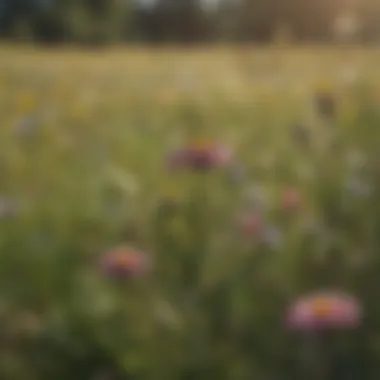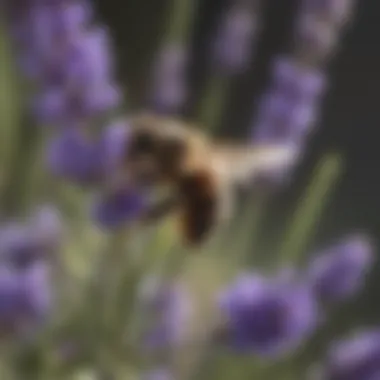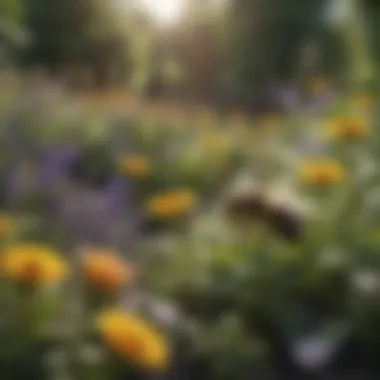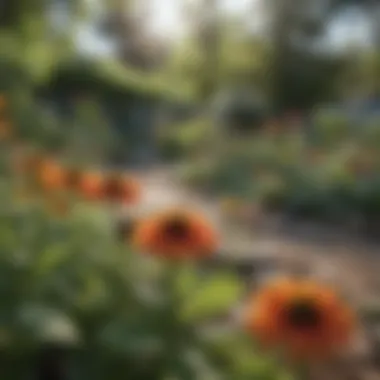Essential Plants to Enhance Bee Populations


Intro
Understanding which plants support bee populations is crucial. Bees are vital for pollination, leading to healthier ecosystems. In this guide, we will analyze various plants, their blooming periods, and characteristics that attract bees. This helps not only bees but also gardeners and land managers aiming to create environments that nourish these insects.
Key Points to Discuss
The article will cover the following:
- The types of plants that are beneficial to bees
- The blooming periods of these plants
- Specific qualities that make flowers appealing to bees
- Practical guidance for creating a bee-friendly garden
This will provide a clear understanding of how to enhance bee populations and, by extension, ecological health.
Types of Plants That Attract Bees
Several plant families have been positively identified as favorites among various bee species. Some notable examples include:
- Asteraceae Family: Includes sunflowers, daisies, and asters. These plants bloom at different times, providing a continuous source of nectar.
- Lamiaceae Family: This family includes herbs like lavender, mint, and sage. Their scents attract bees and they are often easy to grow.
- Boraginaceae Family: Plants like borage and comfrey are known for their bright blue flowers that bees find irresistible.
The idea is that a diversity of plants ensures that bees have access to food sources throughout the growing season.
Blooming Periods
Different plants have distinct blooming schedules. Selecting plants that bloom at various times can extend the feeding period for bees. For instance:
- Early Bloomers: Crocus and snowdrop.
- Mid-season Producers: Coneflowers and bee balm.
- Late Bloomers: Goldenrod and asters.
By knowing the blooming periods, gardeners can design landscapes that provide consistent support for bee populations.
Characteristics of Bee-Friendly Plants
Several features make plants appealing to bees:
- Color: Bees are particularly attracted to blue, purple, and yellow flowers.
- Shape: Tubular flowers can be easier for certain bee species to access nectar.
- Fragrance: Scented flowers draw bees from a distance.
Gardeners should keep these characteristics in mind when selecting plants.
Practical Recommendations for Gardeners
If you aim to create a bee-friendly environment, consider these tactics:
- Plant in clusters rather than solitary specimens to create a more significant visual impact and attract more bees.
- Choose organic gardening methods to avoid pesticide exposure.
- Provide water sources, like shallow dishes with pebbles, for thirsty bees.
Prologue to Bees and Their Importance
Bees are essential to our ecosystems. They play a major role in pollination, which is crucial for the reproduction of many plants, including a large number of crops we rely on. By transferring pollen between flowers, bees help create fruits, vegetables, and seeds. This relationship between bees and plants ensures food security for both humans and animals. Understanding the need for bee populations is vital in our quest to maintain biodiversity and health in nature.
Pollination is not just about feeding the planet. It’s about sustaining entire ecosystems. Healthy bee populations contribute to vibrant flowers, which in turn benefit other wildlife. When there are more flowers, birds and other beneficial insects thrive as well. Therefore, when we support bees, we are indirectly supporting a wider network of life.
However, bees face numerous challenges. Their populations have been declining, leading to alarm for scientists and environmentalists. Here, we will discuss the critical role bees play in pollination and explore the various threats they currently face. By understanding these elements, we can develop effective strategies to ensure their survival, and, as a result, the well-being of ecosystems and agriculture.
The Role of Bees in Pollination
The relationship between bees and flowering plants dates back millions of years. During this time, bees have evolved into highly efficient pollinators. As they gather nectar, they inadvertently collect pollen. This process allows them to fertilize plants as they move from bloom to bloom. Not all bees pollinate equally. Some species, like honeybees and bumblebees, are particularly important due to their effectiveness and the large colonies they form.
Pollination is crucial for many food crops. It is estimated that bees contribute to approximately one third of the food we consume. Fruits such as apples, strawberries, and avocados rely heavily on bee activity for successful crops. Without bees, these plants would struggle to reproduce, resulting in lower yields and potentially impacting food prices and availability.
Threats Facing Bee Populations
Bee populations face a multitude of threats that contribute to their decline. Some of these include:
- Pesticides: Chemical pesticides, particularly neonicotinoids, have been linked to harmful effects on bee health and behavior. These chemicals can kill bees directly or impair their ability to forage and reproduce.
- Habitat Loss: Urbanization, agriculture expansion, and deforestation have led to significant loss of native habitats. As bees depend on diverse flora for food, habitat destruction has severe consequences on their survival.
- Climate Change: Fluctuating temperatures and altered weather patterns disrupt blooming times for plants. This affects food availability for bees, leaving them without sustenance during critical periods.
- Diseases and Parasites: Bees are susceptible to various diseases and parasites, such as the Varroa mite. These can devastate colonies and compromise overall bee health.
Greater awareness of these threats is necessary. Individuals can take steps to mitigate these risks, such as planting bee-friendly gardens, avoiding pesticides, and advocating for local wildlife conservation efforts. By doing so, we contribute to a healthier environment for bees and, ultimately, for ourselves.
Understanding Bee Preferences
Understanding bee preferences is crucial for anyone interested in supporting bee populations through their gardening efforts. Bees have specific needs in terms of food sources and environmental conditions. By knowing what attracts them, gardeners can make informed decisions that enhance the quantity and health of these essential pollinators.


Two primary considerations are the types of bees and their feeding habits. Each bee species has preferred plants that provide the nectar and pollen they depend on. This relationship shapes the ecosystems in which these bees thrive.
Types of Bees and Their Feeding Habits
Bees are not a monolith; they come in diverse species, each with unique feeding habits. The most well-known types include honeybees, bumblebees, and solitary bees. Honeybees are highly social and often forage on a wide variety of plants. They tend to favor large, open flowers that offer abundant access to nectar.
Bumblebees, on the other hand, are also social, but they exhibit different behaviors. They can work in cooler weather and can access flowers that others cannot due to their size and ability to buzz pollinate. This means that flowers like tomatoes and blueberries, which provide a high reward, can particularly attract bumblebees.
Solitary bees, which include mason bees and leafcutter bees, have specific preferences, often favoring particular flowers for nectar and pollen. For instance, mason bees are known to be attracted to early-spring bloomers. The differences in feeding habits illustrate the importance of offering a diverse selection of plants in the garden.
Factors that Attract Bees to Plants
Several factors influence how plants attract bees. Color, scent, and flower shape play critical roles. Bees are primarily attracted to bright colors, especially blue and yellow. These colors stand out in the environment, guiding bees to the nectar.
The scent of a flower can also make a significant difference. Bees can detect floral scents from long distances, which encourages them to visit. Flowers that are fragrant tend to be more inviting.
Moreover, the shape of the flower can control which species visit. For instance, tube-shaped flowers attract long-tongued bees, while flatter blooms cater to short-tongued varieties.
In summary, understanding bee preferences can enrich any garden designed to support these vital pollinators.
Providing a diverse range of plants that bloom at various times throughout the season is essential for creating a healthy bee environment.
By focusing on plant selection that aligns with bee species' unique needs, landowners and gardeners can significantly enhance local bee populations.
Top Plants for Bees
The inclusion of specific plants in gardens significantly influences bee populations. The right flora can either attract these vital pollinators or leave them without support. Selecting the best plants ensures a continuous food supply in various seasons, fostering a healthy ecosystem.
Wildflowers: The Natural Choice
Wildflowers provide an essential resource for bees. Unlike many cultivated plants, wildflowers typically require less maintenance and are well adapted to local conditions. This section explores key wildflower species that benefit bees in the garden.
Sunflowers
Sunflowers are known for their tall, bright blooms which can easily attract bees from a distance. Their large, open flower heads provide easy access to nectar and pollen, making them a preferred choice for various bee species. Moreover, they are known to bloom in summer and fall, extending the feeding period for bees.
Sunflowers also support biodiversity in gardens. They can act as hosts for numerous beneficial insects. However, it's important to consider that they may require full sun and well-drained soil for optimal growth.
Purple Coneflower
Purple Coneflower, or Echinacea purpurea, is well known as a bee-friendly plant. Its robust and colorful petals make it visually appealing while offering valuable nectar. The conical shape of the flower head also matches the foraging preference of many bees, including bumblebees.
The flowering period of Purple Coneflower spans from summer to fall. This duration provides a valuable food source during critical times when other flowers may be scarce. However, the plant may develop a tough exterior as it matures, possibly limiting its appeal for some softer pollen gatherers.
Black-eyed Susan
Black-eyed Susan is another excellent choice for supporting bee populations. The flower's distinct yellow petals surrounding a dark center make it a striking addition to any garden. Its blooms produce ample nectar, particularly attractive to honeybees and native species alike.
Blooming from mid-summer into fall gives this plant a sustained presence in gardens, ensuring bees have consistent access to food sources. Nevertheless, potential growers should note that Black-eyed Susan can spread and may require some management to prevent overcrowding.
Herbs That Attract Bees
Herbs serve a dual purpose in gardens, providing culinary benefits along with attracting bees. Here are some notable herbs that can enrich bee-friendly spaces.
Basil
Basil not only enhances culinary dishes but also attracts bees with its aromatic flowers. When allowed to flower at the end of the growing season, it becomes a hot spot for several bee species. The small, clustered blooms are easily accessible and packed with nectar.
This herb is easy to grow, making it a practical choice. However, the flowering phase can be short-lived, so careful management may ensure extended blooming.
Thyme
Thyme is a low-growing herb that offers both fragrance and utility. Its tiny flowers bloom in clusters, making them exceptionally attractive to small bees. Thyme thrives in well-drained soil and sunny locations, ensuring its popularity in varied garden settings.
Due to its compact size, thyme is suitable for border plantings or ground cover, adding versatility to gardens. One drawback, however, is that it may struggle in overly moist conditions, which could limit its planting potential in certain regions.
Mint


Mint is a perennial favorite among bees and gardeners alike. Its vigorous growth produces clusters of tiny flowers that create a halo of attraction for pollinators. The mint plant often flowers later in summer, supplementing the food sources available during that season.
While mint is beneficial, it can also become invasive if not contained properly. Therefore, garden strategists may need to restrict its spread, perhaps through pots or barriers in the ground.
Garden Favorites
In addition to wildflowers and herbs, certain garden staples greatly support bee populations.
Lavender
Lavender is favored for its beautiful flowers and calming fragrance. The rich purple blooms are known for attracting various bee species, especially honeybees. Its long flowering period, which can extend from late spring to early fall, makes it a continuous food source throughout the warmer months.
Moreover, lavender thrives in poor soil and requires little water, making it a considerate choice for eco-conscious gardeners. However, it does need well-drained soil and tending to pruning for optimal health.
Bee Balm
Bee Balm, or Monarda, earns its name as a bee magnet. Its vibrant red, pink, or purple flowers capture attention, drawing many bee species. Some studies indicate that it can repel certain pests, providing a dual benefit in garden management.
It blooms in mid-to-late summer, which is crucial for bees at that time. Hence, it adds critical sustenance when other flowers may have already finished blooming. Gardeners may need to ensure adequate spacing due to its tendency to spread.
Cosmos
Cosmos are visually pleasing with their array of colors, and they serve as an efficient nectar source. These flowers are particularly attractive to bees due to their open structure, allowing for easy access to nectar and pollen. They bloom from late spring through fall, providing a lengthy food source period.
However, their height can sometimes make them susceptible to wind damage, requiring strategic planting for stability. This factor can influence their viability in taller arrangements.
Fruit and Nut Trees
Fruit and nut trees not only yield harvestable crops but also play a vital role in supporting bee populations.
Apple Trees
Apple trees are celebrated not only for their fruit but also for their blossoms that attract various bee species, especially honeybees. The strong, sweet scent of the flowers draws bees during the early spring when few other plants are in bloom.
An apple tree’s bloom period can be relatively short, yet its impact on early-season pollinators is profound. Bee populations benefit greatly during this time, leading to an abundant fruit yield. Nevertheless, they may require careful attention to prevent pest issues related to fruit production.
Cherry Trees
Cherry trees are delightful to the eye and also serve as a bee haven during their blooming season. The majority of flowers on cherry trees open simultaneously, creating an attractive display for pollinators. The delicateness of the flowers contributes positively to the nectar availability.
However, individual trees may not provide nectar beyond their short blooming season, necessitating surrounding plants for extended pollination support. The diverse array of cultivars allows for extended harvest, enhancing their appeal.
Almond Trees
Almond trees are critical for both agriculture and bee populations. The early bloom of almond blossoms presents bees with essential resources when many other sources are still dormant. This unique position in the growing season allows bees to forage extensively just before the main flowering season begins.
While almond trees provide great benefits, they require cross-pollination through beekeepers and wild bee activity, creating a dependent relationship that underscores the importance of maintaining healthy bee populations.
Incorporating these plants in gardens enhances the local ecosystem. Sustaining a steady flow of blooming plants can assure the health of bee populations, which is instrumental for both agriculture and environmental balance.
Blooming Periods: A Continuous Food Source
The blooming periods of plants play a critical role in supporting bee populations. A continuous food source is essential for the health and survival of bees throughout the seasons. By strategically planting various species that bloom at different times, we can help ensure that bees have access to nectar and pollen from early spring until late fall. This sustained availability of food is vital for their nutrition, enabling them to thrive and maintain their roles as effective pollinators in our ecosystems.
Spring Bloomers
Spring is a crucial time for bees as they emerge from hibernation. The availability of early blooming flowers is essential after a long winter. Some notable spring bloomers include:
- Crocus: These flowers provide nectar and pollen early in the season, attracting bees as soon as they awaken.
- Dandelion: Often seen as a weed, dandelions are an important food source for many bees in spring.
- Bluebells: These vibrant flowers offer abundant nectar and are particularly attractive to honeybees.
By planting a variety of these flowers, gardeners can provide bees with the energy they need to begin their busy season.
Summer Bloomers
As temperatures rise, many plants produce blooms that are rich in food for bees. Summer bloomers are abundant and can support large populations. Key summer bloomers include:
- Sunflowers: Known for their large heads, they provide copious amounts of both nectar and pollen, making them favorites among bees.
- Lavender: This herb is not only prized for its fragrance but also for its long blooming period and high nectar production.
- Bee Balm: This plant is specifically named for its ability to attract bees and provides a vibrant splash of color to gardens.


A diverse selection of summer bloomers guarantees that bees have a reliable food supply during the peak of their activity.
Fall Bloomers
Fall is often overlooked in gardening discussions, but it is equally important for supporting bee populations. As flowers begin to fade in late summer, fall bloomers can provide essential sustenance. Some valuable fall bloomers include:
- Goldenrod: This plant is a top nectar source for late-season bees, helping them stock up on resources before winter.
- Asters: They bloom late in the season, offering important nutrients to bees that are preparing for the colder months ahead.
- Sedum: Known for its thick, succulent leaves, sedum produces small clusters of flowers, which are a good source of nectar in autumn.
Planting these species ensures that even as the weather cools, bees can continue their vital work and prepare for the upcoming winter.
Maintaining a variety of flowering plants from spring to fall is a key strategy for supporting bee populations and enhancing biodiversity.
Creating Bee-Friendly Gardens
Creating bee-friendly gardens is an essential effort to support dwindling bee populations. The design of a garden can greatly impact the health and activity of these important creatures. With the right selection of plants and garden features, one can provide bees with consistent food sources, shelter, and a safe environment. This section outlines key considerations for creating spaces that benefit bees and other pollinators.
Designing with Bees in Mind
When designing a garden with bees in mind, it is crucial to understand their preferences. Bees are attracted to flowers that are bright and fragrant. To maximize bee visits, select a variety of plants that bloom at different times of the year. This ensures a continuous food supply, which is vital for their survival. Additionally, group similar plants together. Clusters of the same species make it easier for bees to forage efficiently.
Bees prefer open flower shapes, which allow them easy access to nectar and pollen. Flowers like lavender, daisies, and sunflowers are popular choices. Avoid overly hybridized plants, as they often have compromised floral structures. In creating these gardens, keeping a natural mix of native plants can also create a vibrant ecosystem.
Avoiding Harmful Chemicals
Chemicals used in gardening, especially pesticides, can harm bee populations. Bees are particularly sensitive to certain pesticides that are toxic during their foraging periods. Opting for organic gardening practices can mitigate these risks. Use natural pest control methods, such as introducing beneficial insects like ladybugs, which can help manage pests without harming bees.
Educating oneself about the labels of products used in the garden is critical. Many garden chemicals are labeled as “bee-safe,” but the terminology can be misleading. Always read labels carefully and consider the timing of application. Applying chemicals during the evening when bees are less active can also minimize exposure.
Important: Effective garden management requires understanding which practices encourage or hinder bee populations.
Maintaining Diversity in Plant Selection
Diversity in plant selection is key to promoting a bee-friendly garden. Different bee species have varying preferences for nectar and pollen sources. By planting a range of species, gardeners can support a wider variety of pollinators. Native plants, in particular, are generally more beneficial. They evolved alongside bees and are better adapted to provide the nutrition bees need.
Including a mixture of flower types, including annuals and perennials, can ensure that blooms are present throughout the seasons. Herbs such as basil, mint, and rosemary can also serve a dual purpose; they attract bees and are useful culinary additions to the garden.
Resources for Further Learning
Understanding the intricacies of bee populations and their related ecosystems is vital for their survival. Accessing diverse resources can significantly enhance one's knowledge about bee conservation. This article section emphasizes the importance of learning materials that not only educate but also inspire individuals to take action for our pollinators. Books and online communities provide substantial information and a platform for discussions, ensuring that readers are well-informed and actively engaged.
Books on Bee Conservation
Books dedicated to bee conservation serve as essential tools for anyone interested in protecting these critical pollinators. They often include a variety of topics, from the biology of bees to practical gardening tips. Titles such as The Bee Book by DK and The Pollinator Friendly Gardening Handbook by Rick Mikula provide valuable insights into creating environments conducive to bee health. These resources offer guidance on:
- Identification of bee species
- Best practices in pesticide management
- Methods to enhance local flora for bees
Further, these books create awareness about the overall ecological importance of bees. Engaging with this literature can motivate readers to implement the practices necessary to support bee populations in their local areas.
Online Communities and Forums
In addition to books, online communities and forums are excellent spaces for continued learning and connection. Platforms such as Reddit and Facebook feature groups focused on bee conservation, allowing enthusiasts to share experiences and resources. These platforms foster a sense of community among gardeners, ecologists, and general bee lovers. Members can:
- Exchange tips on bee-friendly plants
- Discuss the latest research in bee health
- Share their gardening successes and challenges
Engagement in these online discussions enables individuals to refine their understanding of conservation strategies. Being active in these communities contributes to a more informed public and encourages collective efforts in protecting bee populations.
Informed individuals lead to collective action, amplifying the efforts needed to combat the decline of our essential pollinators.
Culmination
The Urgency of Supporting Bee Populations
Bees play a key role in the ecosystem. They are vital for pollination, which affects a vast range of plants. Without bees, many plants struggle to reproduce, leading to reduced food production and loss of biodiversity. In recent years, honeybee and native bee populations face significant decline. This is due to habitat loss, pesticides, and climate change. Given these dangers, it is essential to focus on how we can support these important insects. Encouraging bee populations is an urgent task. By planting bee-friendly flora, we indirectly aid in plant reproduction and contribute to global food security.
The urgency also lies in our awareness of sustainable practices. Educating ourselves and others can create a ripple effect in our communities. This can lead to the restoration of bee-friendly environments. Bees are indicators of ecosystem health. Therefore, their decline impacts all living creatures, including humans.
"If the bees disappear, mankind will only have four years left to live."
— Albert Einstein
Final Recommendations for Planting
When selecting plants to support bee populations, variety is key. Here are several recommendations to consider:
- Choose Native Plants: Native plants are adapted to local climates and require less water and care. They often attract local bee species more effectively.
- Prioritize Blooming Periods: Plant a mix of species that bloom at different times throughout the growing season. This ensures a continuous source of food for bees.
- Include Colorful Flowers: Bees are attracted to a wide range of colors, especially blue, purple, and yellow. Incorporating these colors can increase bee visits to your garden.
- Avoid Pesticides: Chemical pesticides can harm bees. Look for alternatives that are organic or natural.
- Create Clusters of Plants: Grouping plants together encourages more efficient foraging by bees. A larger patch of the same flower type can attract more pollinators.
Planting in harmony with nature ensures healthier ecosystems. With careful thought and action, every garden can become a refuge for these crucial pollinators. Supporting bee populations adds beauty and biodiversity to our surroundings while protecting our own future.







